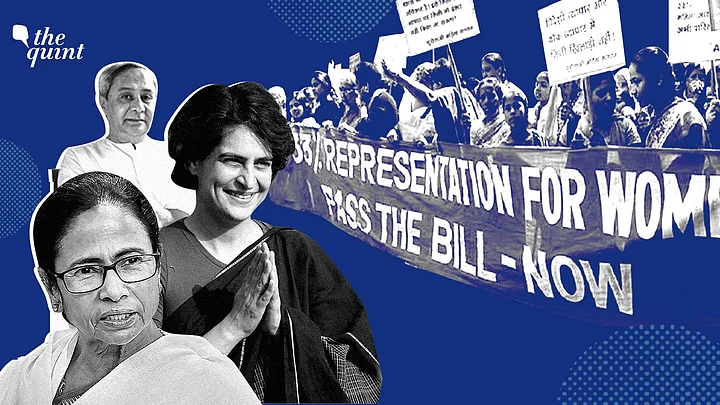(This was first published on 21 October 2021. It has been republished from The Quint's archives after the Congress’ announcement of its first list of candidates for the upcoming Assembly polls in Uttar Pradesh.)
Congress general secretary in-charge for Uttar Pradesh Priyanka Gandhi Vadra announced on Tuesday 19 October, that the party would give 40 percent of its tickets to women in the upcoming UP Assembly elections.
"This is to give a voice to every woman in Uttar Pradesh," Gandhi announced, flanked by two women faces of the party - journalist turned politician Supriya Shrinate and Rampur Khas MLA Aradhana Misra.
This is no doubt an important experiment and any effort to increase representation for women deserves to be praised.
But it is also necessary to look at the possible political impact it may have.
This article will examine two aspects:
How a similar experiment worked (or didn't work) for the two other parties that tried it before the Congress - the Trinamool Congress and the Biju Janata Dal.
Can this help the Congress tap a 'women's vote' in Uttar Pradesh?
THE TMC AND BJD EXPERIMENTS
In the 2019 Lok Sabha elections, Mamata Banerjee's TMC announced that it would give 40 percent of its tickets to women. The party fielded 17 women candidates out of the 42 Lok Sabha seats in West Bengal. Out of these, nine emerged victorious - a winning percentage of a little over 50 percent. TMC's male candidates had a similar winning percentage - 13 out of 25.
Naveen Patnaik's BJD gave tickets to seven women out of the 21 Lok Sabha seats in Odisha. Five out of seven got elected. BJD's women candidates had a better winning percentage than its male candidates.
Both the TMC's experiment in Bengal and that of the BJD in Odisha were reasonably successful.
NOT JUST ABOUT REPRESENTAITON
Some would argue that there are cultural differences between UP on one hand and Odisha and West Bengal on the other. But there may be a bigger factor at play than that.
It is significant that both the TMC and the BJD are in power in their respective states. Both the governments initiated a number of welfare schemes aimed at women, which had an impact among poorer women in particular.
In the Bengal for instance, the TMC had nearly 20 percentage point lead over the BJP among poorer women, while the latter led among richer women according to the Lokniti-CSDS survey for the 2021 Assembly polls.
The most stark was the case of Adivasi women. The Quint found that in several Adivasi households, women were supporting the TMC while men were with BJP.
This is supported by data as well. According to CSDS, the TMC had a 11 percentage points lead over BJP among Adivasi women, while the BJP had an 18 point lead among Adivasi men.
In its ground reports, The Quint found out that a lot of this was due to schemes providing food and cash benefits to poorer households.
In Odisha too the government won the support of women through a variety of targeted schemes - from providing health insurance to female family members, to allowances for pregnant women, smartphones for women farmers and sanitary napkins for teenage girls to name a few.
One of the BJD's MPs is Pramila Bisoyi, who has been part of the Self Help Group movement in Odisha. Her presence shows how representation and development schemes go together.
CAN THE CONGRESS REPLICATE THIS IN UP?
Not being in government is a major obstacle for the Congress and may impede the extent to which it can gain support among women.
While the BJD and TMC cases do show a moderate difference between male and female support, it can also be argued that women may not have supported these parties to the same extent had they been fundamentally weak in their respective states.
Providing 40 percent reservation to women may give Congress a marginal increase but it won't make much of a difference unless there is an overall increase in support for the party.
Then there's another problem. Once the party has taken such a step, its conduct regarding women would be judged with a much harsher yardstick than other parties. For instance, the party would need to work hard to prevent incidents like what is said to have happened in Balia a year ago - in which a female party worker was allegedly manhandled.
LONG TERM PROJECT
The party itself is being realistic as far as the political gains from this are concerned. During her press conference in Lucknow, Priyanka Gandhi herself said that, "Women may not consolidate as a separate voting bloc in this election, they might consolidate in the next election or some time in the future".
This is a clear indication that the Congress considers this as a matter of principle and not necessarily a vote-gathering measure.
In any case, Uttar Pradesh is a good state to begin this experiment. As it is the party may not have a realistc shot at coming to power in the upcoming Assembly poll. It may be beneficial to it in the long run if it tries to try a new kind of politics in the state.
(At The Quint, we question everything. Play an active role in shaping our journalism by becoming a member today.)
